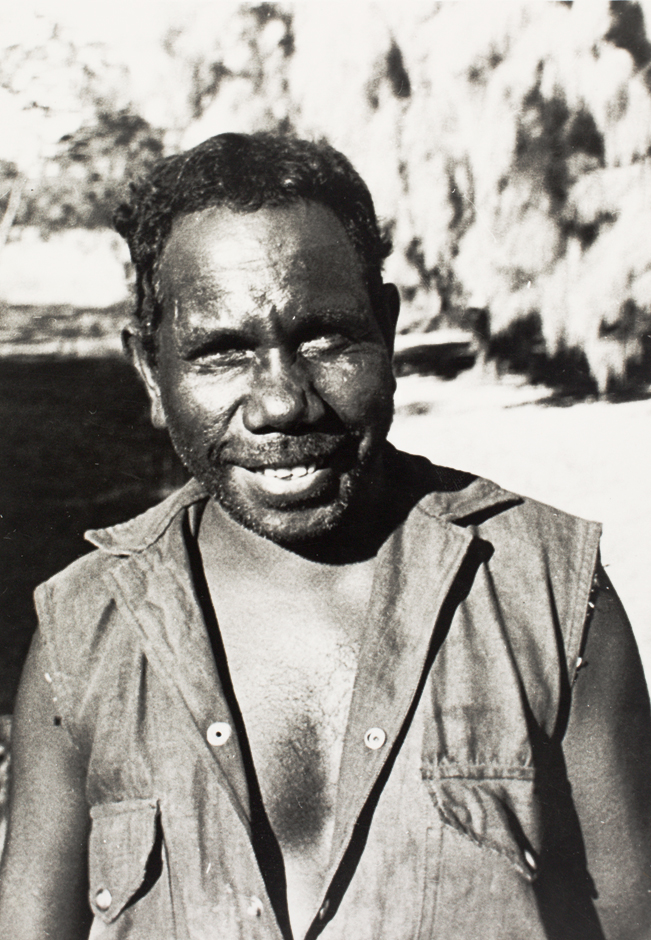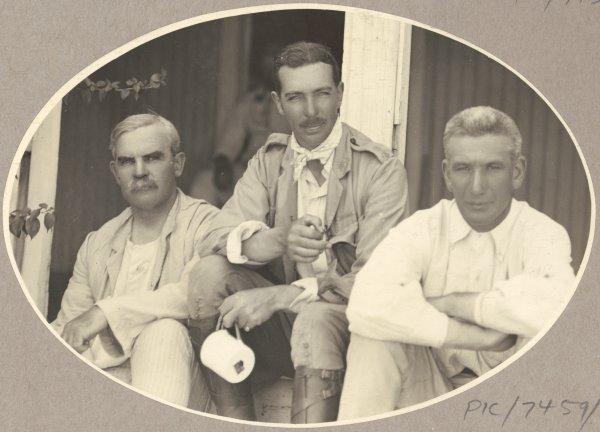|
Dexter Daniels (Aboriginal Activist)
Dexter Daniels (1938 – ) was a pioneering activist in the struggle for Aboriginal Australian, Aboriginal rights and land rights in Australia during the 1960s and 1970s. Daniels came to public attention as the breakaway Aboriginal Organiser of the North Australian Workers' Union (NAWU) in 1966 and was integral in supporting the Wave Hill walk-off. Early life Daniels was born at the Roper River Mission, Roper River Church Missionary Society mission in the Northern Territory of Australia. Established in 1908, it brought together the remaining fragments of groups previously occupying a wide area of the Roper basin and South East Arnhem Land. Daniels was one of many Indigenous activists from the Roper Mission who went on to become deeply involved in social and political struggles in the Northern Territory. They included the Roberts brothers, Clancy, Jacob and Phillip and Dexter Daniels and his brother Davis. "That's not right" was a response of which Daniels was "very fond" when di ... [...More Info...] [...Related Items...] OR: [Wikipedia] [Google] [Baidu] |
Dexter Daniels
Dexter Daniels may refer to: * Dexter Daniels (American football) (1973–), American football linebacker * Dexter Daniels (Aboriginal activist) (1932–c. 1990), Australian Aboriginal activist {{hndis, Daniels, Dexter ... [...More Info...] [...Related Items...] OR: [Wikipedia] [Google] [Baidu] |
Robert Tudawali
Robert Tudawali (1929 – 26 July 1967), also known as Bobby Wilson and Bob Wilson, was an Australian actor and Indigenous activist. He is known for his leading role in the 1955 Australian film ''Jedda'', which made him the first Indigenous Australian film star, and also his position as Vice-President of the Northern Territory Council for Aboriginal Rights. The Tudawali Indigenous Film and Television Awards (Tudawali Awards) continue to recognise outstanding achievements of Indigenous people in the Australian film industry. Early life Tudawali was born and raised on Melville Island in the Northern Territory to Tiwi parents. Although he had only a basic education in Kahlin Compound and Half Caste Home in Darwin, Tudawali gained a rich English vocabulary. He was a leading Australian rules footballer as a youth, and he alternated several times between Aboriginal and white society. He used the name Bobby Wilson in Darwin when he travelled there by canoe in the late 1930s, u ... [...More Info...] [...Related Items...] OR: [Wikipedia] [Google] [Baidu] |
Katherine, Northern Territory
Katherine is a town in the Northern Territory of Australia. It is situated on the Katherine River, after which it is named, southeast of Darwin. It is the fourth largest settlement in the Territory and is known as the place where "The outback meets the tropics". Katherine had an urban population of approximately 6,300 at the 2016 Census. Katherine is also the closest major town to RAAF Base Tindal, located southeast, and provides education, health, local government services and employment opportunities for the families of Defence personnel stationed there. In the , the base had a residential population of 857, with only around 20% of the workforce engaged in employment outside of defence, the majority commuting to work in Katherine. Katherine is also the central hub of the great " Savannah Way" which stretches from Cairns in north Queensland to Broome in the Kimberley region of Western Australia. Beginning as an outpost established with the Australian Overland Teleg ... [...More Info...] [...Related Items...] OR: [Wikipedia] [Google] [Baidu] |
Aboriginal Reserve
An Aboriginal reserve, also called simply reserve, was a government-sanctioned settlement for Aboriginal Australians, created under various state and federal legislation. Along with missions and other institutions, they were used from the 19th century to the 1960s to keep Aboriginal people separate from the white Australian population, for various reasons perceived by the government of the day. The Aboriginal reserve laws gave governments much power over all aspects of Aboriginal people’s lives. Protectors of Aborigines and (later) Aboriginal Protection Boards were appointed to look after the interests of the Aboriginal people. History Aboriginal reserves were used from the nineteenth century to keep Aboriginal people separate from the white Australian population, often ostensibly for their protection. Protectors of Aborigines had been appointed from as early as 1836 in South Australia (with Matthew Moorhouse as the first permanent appointment as Chief Protector in 1839), wi ... [...More Info...] [...Related Items...] OR: [Wikipedia] [Google] [Baidu] |
Kalkaringi
Kalkaringi (formerly Wave Hill Welfare Settlement, also spelt Kalkarindji ) is a town and locality in the Northern Territory of Australia, located on the Buntine Highway about south of the territory capital of Darwin and located about south of the municipal seat in Katherine. History Kalkarindji and the nearby settlement of Daguragu are the population centres of the land formerly held under the Wave Hill Cattle Station. In 1966, the Aboriginal station workers, led by Vincent Lingiari, staged the Gurindji strike, also known as the Wave Hill Walk Off, in protest against oppressive labour practices and land dispossession. A portion of land was returned to the Gurindji people in by UK-based station owners, the Vestey Group, after negotiations by the Whitlam government in 1975. Kalkarindji reportedly began in 1972 as the "Wave Hill Aboriginal Township." On 5 October 1976, land was associated with existing settlement was proclaimed under the Northern Territory’s Crown Land ... [...More Info...] [...Related Items...] OR: [Wikipedia] [Google] [Baidu] |
Bulgaria
Bulgaria (; bg, България, Bǎlgariya), officially the Republic of Bulgaria,, ) is a country in Southeast Europe. It is situated on the eastern flank of the Balkans, and is bordered by Romania to the north, Serbia and North Macedonia to the west, Greece and Turkey to the south, and the Black Sea to the east. Bulgaria covers a territory of , and is the sixteenth-largest country in Europe. Sofia is the nation's capital and largest city; other major cities are Plovdiv, Varna and Burgas. One of the earliest societies in the lands of modern-day Bulgaria was the Neolithic Karanovo culture, which dates back to 6,500 BC. In the 6th to 3rd century BC the region was a battleground for ancient Thracians, Persians, Celts and Macedonians; stability came when the Roman Empire conquered the region in AD 45. After the Roman state splintered, tribal invasions in the region resumed. Around the 6th century, these territories were settled by the early Slavs. The Bulgars, led ... [...More Info...] [...Related Items...] OR: [Wikipedia] [Google] [Baidu] |
Sofia
Sofia ( ; bg, София, Sofiya, ) is the capital and largest city of Bulgaria. It is situated in the Sofia Valley at the foot of the Vitosha mountain in the western parts of the country. The city is built west of the Iskar river, and has many mineral springs, such as the Sofia Central Mineral Baths. It has a humid continental climate. Being in the centre of the Balkans, it is midway between the Black Sea and the Adriatic Sea, and closest to the Aegean Sea. Known as Serdica in Antiquity and Sredets in the Middle Ages, Sofia has been an area of human habitation since at least 7000 BC. The recorded history of the city begins with the attestation of the conquest of Serdica by the Roman Republic in 29 BC from the Celtic tribe Serdi. During the decline of the Roman Empire, the city was raided by Huns, Visigoths, Avars and Slavs. In 809, Serdica was incorporated into the Bulgarian Empire by Khan Krum and became known as Sredets. In 1018, the Byzantines ended Bulgarian r ... [...More Info...] [...Related Items...] OR: [Wikipedia] [Google] [Baidu] |
World Festival Of Youth And Students
The World Festival of Youth and Students is an international event organized by the World Federation of Democratic Youth (WFDY) and the International Union of Students after 1947. History The festival has been held regularly since 1947 as an event of global youth solidarity for democracy and against war and imperialism. The largest festival was the 6th, held in 1957 in Moscow, when 34,000 young people from 131 countries attended the event. This festival also marked the international debut of the song "Moscow Nights", which subsequently went on to become a widely recognized Russian song. There were no festivals between 1962 and 1968, as events proposed in Algeria and then Ghana were cancelled due to coups and political turmoil in both countries. Until the 19th festival in Sochi, Russia in 2017 (with 185 countries participating), the largest festival by number of countries with participants was the 13th, held in 1989 in Pyongyang when 177 countries attended the event. The most re ... [...More Info...] [...Related Items...] OR: [Wikipedia] [Google] [Baidu] |
The Canberra Times
''The Canberra Times'' is a daily newspaper in Canberra, Australia, which is published by Australian Community Media. It was founded in 1926, and has changed ownership and format several times. History ''The Canberra Times'' was launched in 1926 by Thomas Shakespeare along with his oldest son Arthur Shakespeare and two younger sons Christopher and James. The newspaper's headquarters were originally located in the Civic retail precinct, in Cooyong Street and Mort Street, in blocks bought by Thomas Shakespeare in the first sale of Canberra leases in 1924. The newspaper's first issue was published on 3 September 1926. It was the second paper to be printed in the city, the first being ''The Federal Capital Pioneer''. Between September 1926 and February 1928, the newspaper was a weekly issue. The first daily issue was 28 February 1928. In June 1956, ''The Canberra Times'' converted from broadsheet to tabloid format. Arthur Shakespeare sold the paper to John Fairfax ... [...More Info...] [...Related Items...] OR: [Wikipedia] [Google] [Baidu] |
Tribune (Sydney Newspaper)
''Tribune'' was the official newspaper of the Communist Party of Australia. It was published by the Central Committee of the Communist Party of Australia from 1939 to 1991. Initially it was subtitled as ''Tribune: The People's Paper''. It was also published as the ''Qld Guardian'', ''Guardian'' (Melbourne), ''Forward'' (Sydney). It had previously been published as '' The Australian Communist'', (1920-1921) '' The Communist'', (1921-1923) and the ''Workers' Weekly'' (1923-1939). The ''Tribune'' for the years 1939–1976 has been digitised, as part of the Australian Newspapers Digitisation Program of the National Library of Australia. Publication history The ''Tribune'' was the flagship of Australia's left wing newspapers. ''Two competing papers'' Two newspapers claiming to represent the Communist Party of Australia were published 1920–1921: :''The Australian Communist'' was a weekly newspaper published from Sydney, Australia between 24 December 1920 and 29 April 1921. In ... [...More Info...] [...Related Items...] OR: [Wikipedia] [Google] [Baidu] |
Sydney
Sydney ( ) is the capital city of the state of New South Wales, and the most populous city in both Australia and Oceania. Located on Australia's east coast, the metropolis surrounds Sydney Harbour and extends about towards the Blue Mountains to the west, Hawkesbury to the north, the Royal National Park to the south and Macarthur to the south-west. Sydney is made up of 658 suburbs, spread across 33 local government areas. Residents of the city are known as "Sydneysiders". The 2021 census recorded the population of Greater Sydney as 5,231,150, meaning the city is home to approximately 66% of the state's population. Estimated resident population, 30 June 2017. Nicknames of the city include the 'Emerald City' and the 'Harbour City'. Aboriginal Australians have inhabited the Greater Sydney region for at least 30,000 years, and Aboriginal engravings and cultural sites are common throughout Greater Sydney. The traditional custodians of the land on which modern Sydney stands ... [...More Info...] [...Related Items...] OR: [Wikipedia] [Google] [Baidu] |






